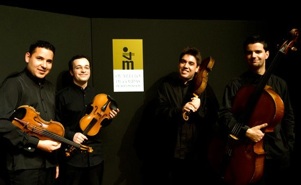
“Comment le taire?”
2012.02.14
English translation: Jakub Szczypa
Quarteto de Cordas de Matosinos
The second concert of the Matosinhos String Quartet 2012 Concert Season took place at the Cine-Teatro Constantino Nery on February 8th, differently to what had been previously announced. The concert allowed us to listen to one of the recent commissions of the Matosinhos Municipality: “Contrafacção folclórica” by Telmo Marques. As referred to in the previous text from January 25th, these commissions had Portuguese traditional music as a point of reference, obviously letting the composers choose the method of its integration within their personal languages. In substitution to the previously announced piece by Paulo Ferreira-Lopes, the Quartet performed “Le feu qui dort” by Miguel Azguime, work written in 2009, and which was also the object of the Municipality’s commission. I believe that the coexistence of the two works during one concert, allows for a convenient reflection on two types of attitudes concerning the composers’ activity.
Although the term “counterfeiting” (“contrafacção”) acquired a pejorative connotation, originally, in a musical context, it used to denote merely the use of the same music with different texts. After that, already in the heart of the 20th century, it came to mean the conscious use of any model as a base for elaborating a score. In this case, the model is not any folklore, but rather, a specific moment of its elaboration in a classical music language. We encounter ourselves facing a stylistic exercise, sounding like an imaginary modernist folklore, common in the music of the past century and masterly represented in Portugal by a Fernando Lopes-Graça. It may be said in Telmo Marques’ favour that the three parts, which constitute the work, are technically solid, demonstrate musicality, instrumental idiomatic features and a secure sense of effect. At the same time, presenting his work, the composer does not hide himself behind a pseudo-aesthetic discourse with which, many times, certain authors try to hide their limitations, commodities and more conformist choices.
“Le feu qui dort” takes its title from a French poem by Mário Dionísio and posses a notable and subtle singularity. The technical and linguistic clarity is undermined or, preferably, emphasised by a discourse, in which, paradoxically, the characteristic elements of Miguel Azuime’s language appear treated as authentic objets trouvés. This attitude creates unsuspected overtones, with a kind of alchemic maceration of the sound material.
I think it is not abusive to refer the reader to the poetic text, which inspired the work, recalling what the poet said: “le feu qui dort est éveillé” (“the fire, which sleeps is awake”). Facing the variety, the irreducible complexity and, even, the disarray of the sound universe, one can feel and conceive the composer’s profession as a competent craftwork, collecting styles, here and there, in a more or less distant manner, as a rule of reference, in search for a personal poetics. Yet without any hint of paradox, without the subcutaneous flame (“under the skin of my whole body” says Mário Dionísio in the same poem), whatever form it assumes, the emptiness of the discourse is almost inevitable. It is a sinuous path; open to diversions, perplexities and failures, but also to some provisory and compensating victories. Quoting the poet: “How to keep him quiet?”
To conclude, I should mention the quality of the performers, hand in hand with the Matosinhos Municipality’s effort, which has been flattering the string quartet, the king-genre of chamber music. Let us hope that the much-talked-about crisis, with its temptation to define priorities hastily, will not suppress, neither such a fundamental cultural option, nor the politics of commissions, which helped to construct a varied and extensive repertoire of Portuguese contemporary music.



